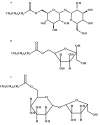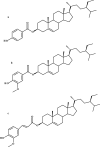Recent advances in the enzymatic synthesis of lipophilic antioxidant and antimicrobial compounds
- PMID: 34873650
- PMCID: PMC8648661
- DOI: 10.1007/s11274-021-03200-5
Recent advances in the enzymatic synthesis of lipophilic antioxidant and antimicrobial compounds
Abstract
Due to the increase in the consumption of highly processed food in developed countries, as well as, a growing number of foodborne diseases, exploration of new food additives is an issue focusing on scientific attention and industrial interest. Functional compounds with lipophilic properties are remarkably desirable due to the high susceptibility to the deterioration of lipid-rich food products. This paper in a comprehensive manner provides the current knowledge about the enzymatic synthesis of lipophilic components that could act as multifunctional food additives. The main goal of enzymatic lipophilization of compounds intentionally added to food is to make these substances soluble in lipids and/or to obtain environmentally friendly surfactants. Moreover, lipase-catalyzed syntheses could result in changes in the antioxidant and antimicrobial activities of phenolic compounds, carbohydrates, amino acids (oligopeptides), and carboxylic acids. The review describes also the implementation of a new trend in green chemistry, where apart from simple and uncomplicated chemical compounds, the modifications of multi-compound mixtures, such as phenolic extracts or essential oils have been carried out.
Keywords: Antimicrobial compounds; Food additives; Lipase; Lipase-catalyzed ester synthesis; Lipophilic antioxidants; Lipophilization.
© 2021. The Author(s).
Conflict of interest statement
The authors declare no conflict of interest.
Figures








Similar articles
-
Lipase-Catalyzed Synthesis, Antioxidant Activity, Antimicrobial Properties and Molecular Docking Studies of Butyl Dihydrocaffeate.Molecules. 2022 Aug 7;27(15):5024. doi: 10.3390/molecules27155024. Molecules. 2022. PMID: 35956977 Free PMC article.
-
Phenolic acids enzymatic lipophilization.J Agric Food Chem. 2005 Apr 20;53(8):2779-87. doi: 10.1021/jf0484273. J Agric Food Chem. 2005. PMID: 15826020 Review.
-
Enzymatic continuous-flow preparation of nature-inspired phenolic esters as antiradical and antimicrobial agents.Food Chem. 2022 Oct 1;390:133195. doi: 10.1016/j.foodchem.2022.133195. Epub 2022 May 12. Food Chem. 2022. PMID: 35594770
-
Lipases in lipophilization reactions.Biotechnol Adv. 2007 Nov-Dec;25(6):515-36. doi: 10.1016/j.biotechadv.2007.06.001. Epub 2007 Jul 10. Biotechnol Adv. 2007. PMID: 17681737 Review.
-
Application of freeze-dried Yarrowia lipolytica biomass in the synthesis of lipophilic antioxidants.Biotechnol Lett. 2021 Mar;43(3):601-612. doi: 10.1007/s10529-020-03033-6. Epub 2020 Oct 26. Biotechnol Lett. 2021. PMID: 33104936 Free PMC article.
Cited by
-
Dihydrocaffeic Acid-Is It the Less Known but Equally Valuable Phenolic Acid?Biomolecules. 2023 May 18;13(5):859. doi: 10.3390/biom13050859. Biomolecules. 2023. PMID: 37238728 Free PMC article. Review.
-
Antimicrobial Potential of Polyphenols: An Update on Alternative for Combating Antimicrobial Resistance.Med Chem. 2024;20(6):576-596. doi: 10.2174/0115734064277579240328142639. Med Chem. 2024. PMID: 38584534 Review.
-
Metabolic engineering of hairy root cultures in Beta vulgaris for enhanced production of vanillin, 4-hydroxybenzoic acid, and vanillyl alcohol.Front Bioeng Biotechnol. 2024 Oct 2;12:1435190. doi: 10.3389/fbioe.2024.1435190. eCollection 2024. Front Bioeng Biotechnol. 2024. PMID: 39416280 Free PMC article.
-
Recent insight into the advances and prospects of microbial lipases and their potential applications in industry.Int Microbiol. 2024 Dec;27(6):1597-1631. doi: 10.1007/s10123-024-00498-7. Epub 2024 Mar 15. Int Microbiol. 2024. PMID: 38489100 Review.
-
Lipase-Catalyzed Synthesis, Antioxidant Activity, Antimicrobial Properties and Molecular Docking Studies of Butyl Dihydrocaffeate.Molecules. 2022 Aug 7;27(15):5024. doi: 10.3390/molecules27155024. Molecules. 2022. PMID: 35956977 Free PMC article.
References
-
- Antonopoulou I, Papadopoulou A, Iancu L, Cerullo G, Ralli M, Jütten P, Piechot A, Faraco V, Kletsas D, Rova U, Christakopoulos P. Optimization of enzymatic synthesis of L-arabinose ferulate catalyzed by feruloyl esterases from Myceliophthora thermophila in detergentless microemulsions and assessment of its antioxidant and cytotoxicity activities. Process Biochem. 2018;65:100–108. doi: 10.1016/j.procbio.2017.11.009. - DOI
-
- Belitz HD, Grosch W, Schieberle P. Food chemistry. Berlin Heidelberg: Springer-Verlag; 2009.
Publication types
MeSH terms
Substances
LinkOut - more resources
Full Text Sources
Medical

